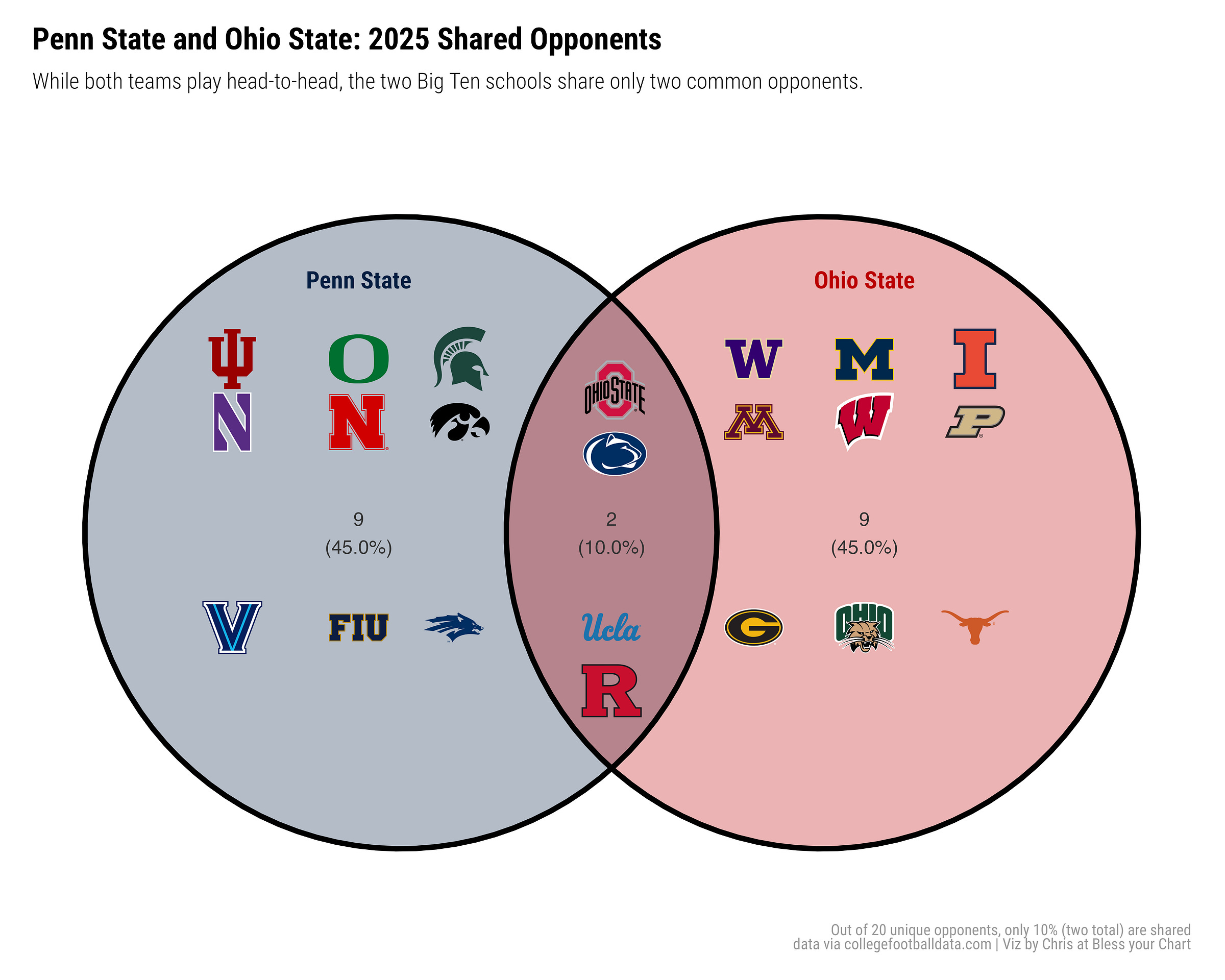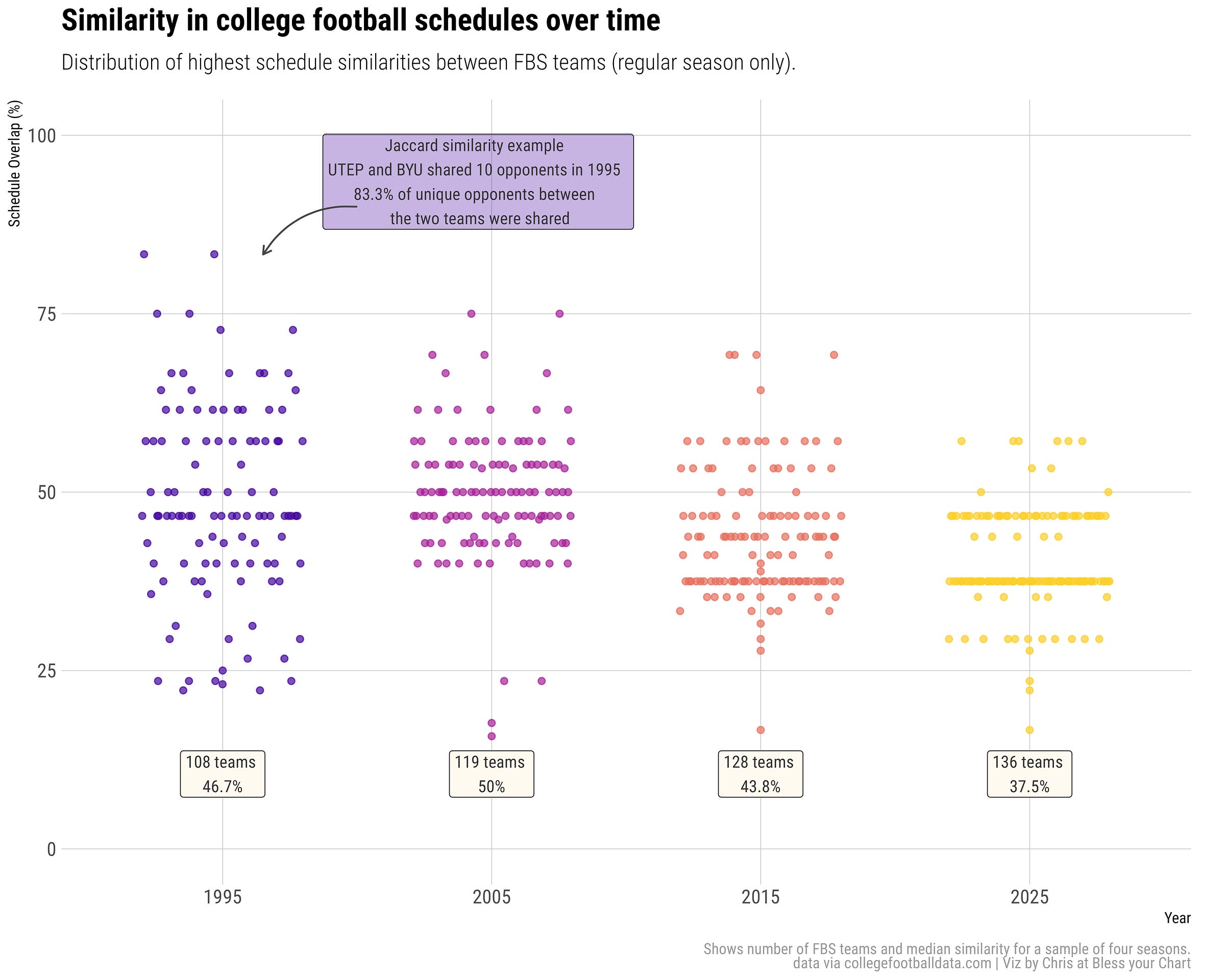150: Schedule similarity
Instead of schedule difficulty, what if we tried to measure schedule similarity?
The college football season is less than two weeks away. The preseason AP Poll and Coaches Poll are out. Many podcasts are debating win totals for teams and previewing conferences.
Much of the discourse is about schedule difficulty. From teams with a cupcake schedule to an absolute gauntlet.
Enough about schedule difficulty, what if we try to measure schedule similarity?
One way to measure the similarity of two team’s schedule is to use the Jaccard Index. Paul Jaccard, a 19th-century professor in botany and plant physiology, developed the index to compare the similarity between different plant species.
Let’s try to apply it to college football schedules.
In our example, we’ll use Penn State and Ohio State. Both members of the Big Ten and both in the top-5 of the preseason AP Poll and Coaches Poll.
First, let’s look at the list of opponents of each team for the 2025 regular season:
Penn State: Nevada, Florida International, Villanova, Oregon, Northwestern, Indiana, Nebraska, UCLA, Iowa, Ohio State, Michigan State, Rutgers
Ohio State: Texas, Ohio, Grambling, Minnesota, Penn State, UCLA, Rutgers, Washington, Illinois, Wisconsin, Purdue, Michigan
The two teams will meet in a head-to-head matchup on November 1. Outside of that game, there are 20 unique opponents and two shared opponents (UCLA, Rutgers).
The Jaccard index is the size of the intersection (two shared opponents) divided by the size of the union (the 20 unique opponents played by both teams).
While the Big Ten campaigns about playing nine conference games, it’s sort of amazing there are only two common opponents between these two teams this season.
This is a consequence of conference realignment, more conference games, and a rise in FCS opponents. This isn’t limited to the Big Ten either.
Alabama and Texas are members of the SEC. The Tide and Longhorns share only three common FBS opponents this season (Oklahoma, Vanderbilt, and Georgia).
Despite playing in a completely different conference, that’s an identical number of shared opponents as Clemson and Alabama (LSU, Florida State, South Carolina).
Georgia and Alabama play head-to-head this season too, but both teams share only two common FBS opponents (Tennessee and Auburn).
Schedule similarity isn’t a measure of connectivity or the strength of a team’s schedule. Schedule strength is more nuanced. It should include where and when games are played.
The Jaccard index is only a simple measure of an overlap in opponents. It might be more interesting than useful at this point, but it can also be fun to remember in November when we’re all debating strength of schedule.
To understand whether this is a recent phenomenon, let's look at how this has changed over time.
How has this changed over time?
In general, college football schedules now have fewer common opponents.
If we take a sample over the past 30 years using the 1995, 2005, 2015, and 2025 seasons we can get a better idea. This plot shows the distribution of the highest schedule similarities between FBS teams for those regular seasons.
UTEP and BYU were both members of the Western Athletic Conference in 1995. The two teams did not play each other, however, they shared 10 common opponents.
The Jaccard index is shown as percentages for easier interpretation, you can see the decline in schedule similarity over time.
Why the decline?
Expansion: college football has expanded. There were 108 FBS teams in 1995 compared to 136 teams today.
Realignment: conference realignment has disregarded geography and simultaneously created less interconnectivity and schedule similarity. This is something we discussed with Brian Fremeau last week in our Q&A about college football.
FCS opponents: As Fremeau notes this week, another reason is an increase in scheduling FCS opponents. Out of the 136 FBS teams in 2025, 126 of those teams are scheduled to play an FCS opponent or 92.6%. This is up from 88.8% in 2024.
List of all 136 FBS teams
The following table shows how this plays out across all FBS teams for 2025.
This is a paginated list of all 136 FBS teams and the team or teams with the most similar schedule this regular season. This only includes FBS opponents, so it excludes any games against FCS teams. Teams are sorted in descending order by highest Jaccard index.
Thanks for reading this far.
As the season approaches, I’m continuing to work on trying to surface more data. For now, you can find team profiles with schedule data here. For example, did you know Miami plays only four true road games this season and doesn’t leave the state of Florida until November?
A recommendation this week is this short ~30 minute-ish Phantom Island podcast with Steven Godfrey and Parker Fleming about building a college football roster. It includes takeaways from the 2025 Personnel and Recruiting Symposium. The more college football changes, the more it stays the same?
The market remains clear as mud.
Anyhow, subscribe below and enjoy your Wednesday.



